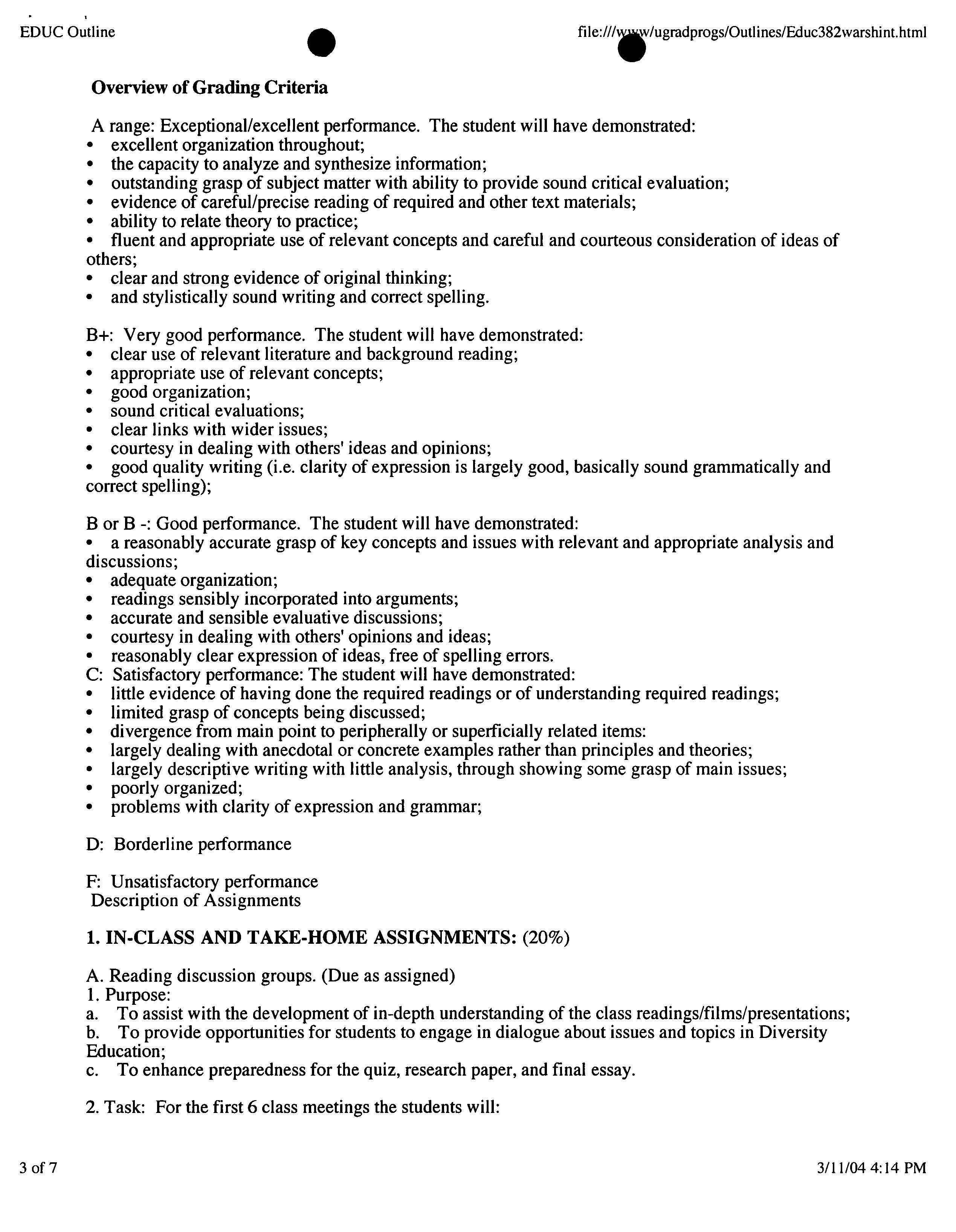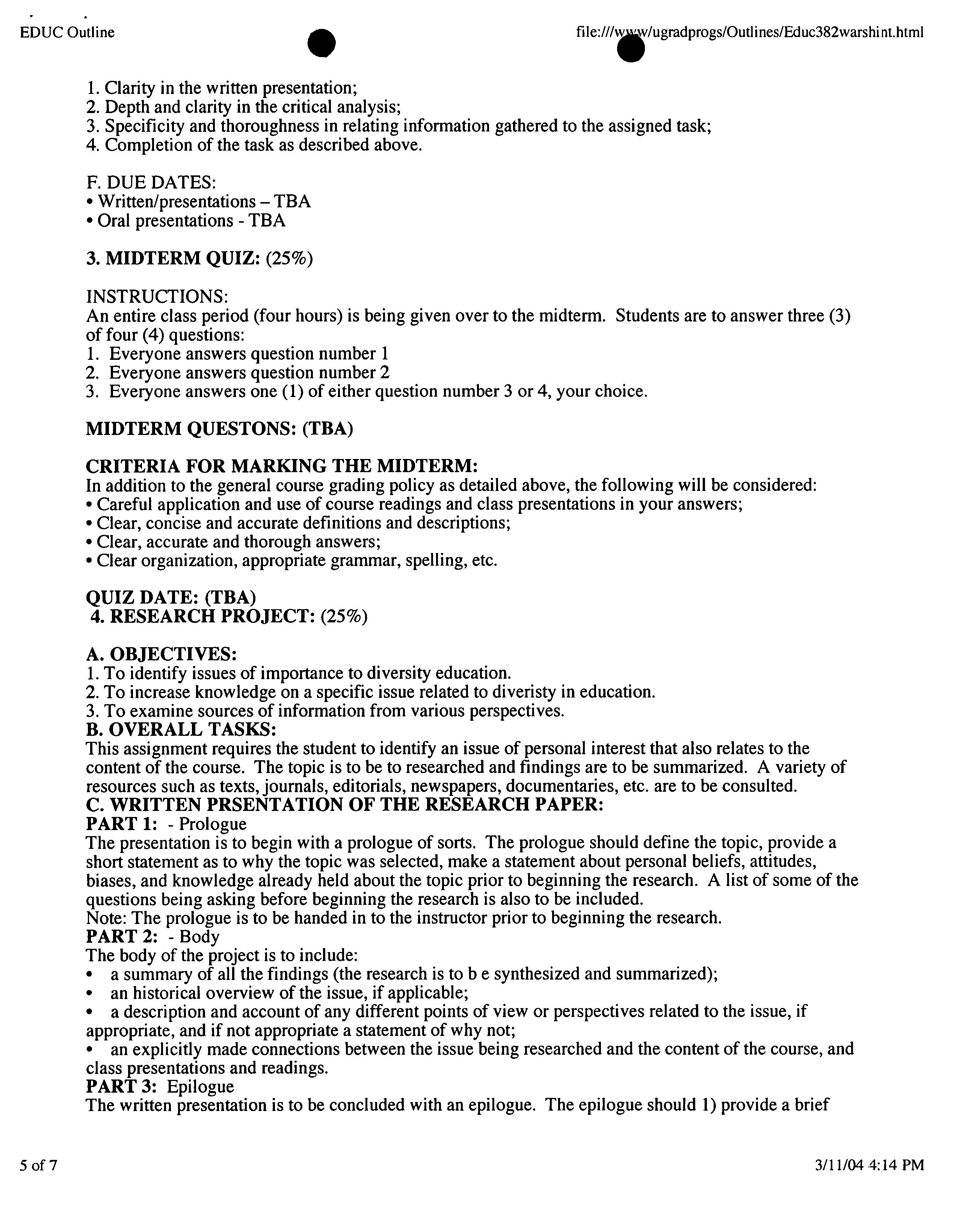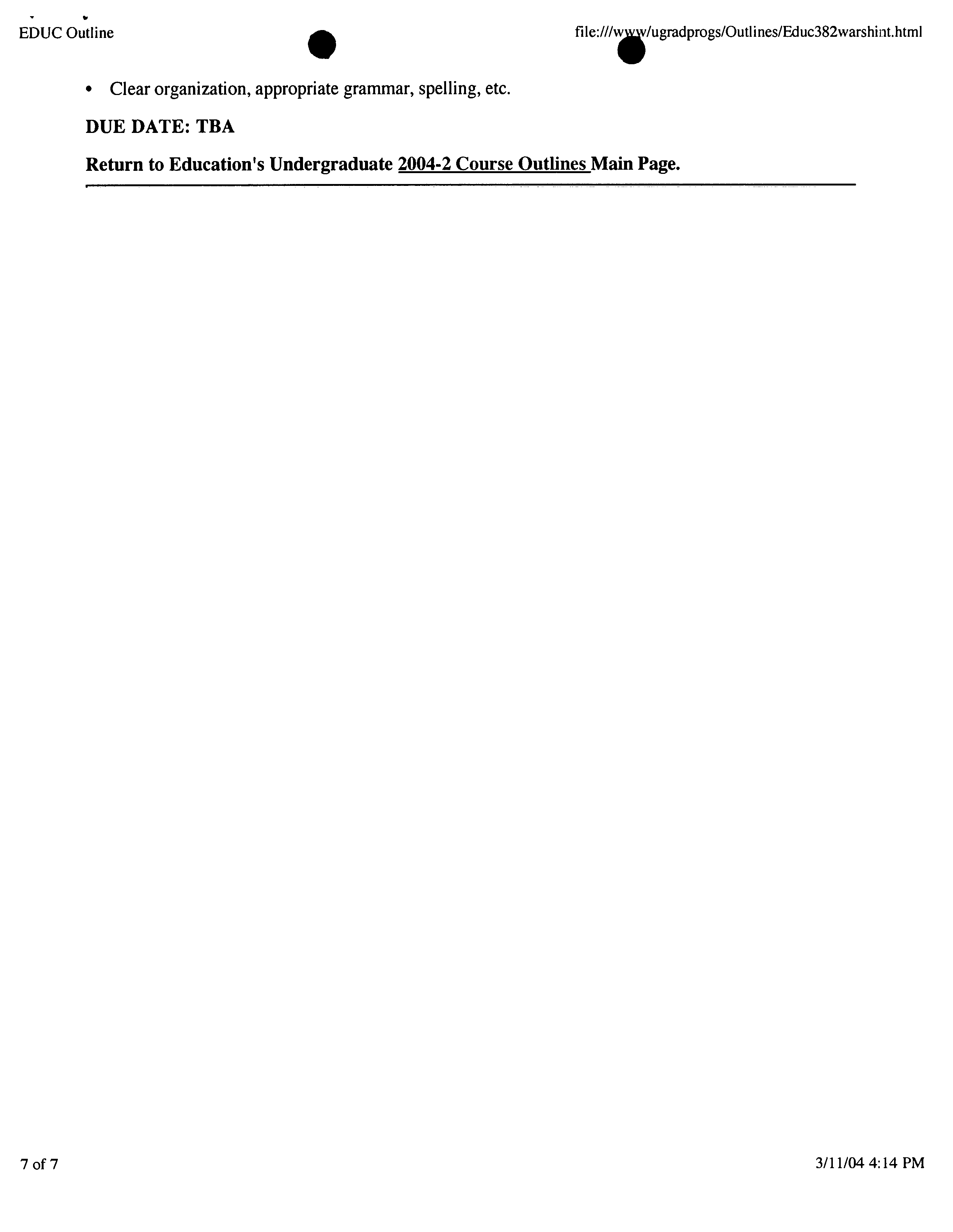EtUC
Outline ?
file:///w/ugradprogs/Outlines/Educ382warshint.html
SIMON FRASER UNIVERSITY ?
SUMMER SEMESTER(Intersession)2004
EDUC 382-4 ?
SPECIAL TOPICS: ISSUES IN DIVERSITY IN
?
EDUCATION
(DO1.00)
COURSE WEBSITE: TBA
M. Warsh
604-294-2552
Terrace
PREREQUISITE:
This course is available to students who have completed a minimum of 6 semester
credits taken from Education, the Social Sciences and/or the Humanities, or upon approval of the
instructor.
Description of Course:
This course is based on both practical and theoretical orientations to issues having to do with diversity in
Canadian education. It will be organized around the central theme, "the politics of diversity and its
impact on schooling." Students will survey school responses to diversity historically and examine
educational principles, practices, and perspectives related to a number of issues, such as cultural, ethnic,
racial, linguistic and religious diversity, and socio-economic, gender and ability differences in
schooling.
Objectives: Learning outcomes for students:
The course will comprise of a range of learning experiences, including: 1) individual study and
fieldwork assignments, 2) small-group and whole-class discussions, seminars and problem-solving
activities, 3) written and oral presentations, lectures and workshops. Specifically, the participants will:
• become conversant with some of the major issues having to do with linguistic, ethnic and cultural
diversity, and with gender differences in
schools;
• become conversant with the history of diversity in education in Canada and British Columbia;
• become conversant with the underlying political and education mandates that pertain to diversity in
BC schools;
• reflect on what culture, gender, linguistic and economic difference mean to individuals and groups;
• examine and begin to develop some understanding of the context for and implications of how
diversity is addressed in classrooms and schools;
• examine school curriculum and learning materials for stereotyping and bias;
• become knowledgeable about the ways that teachers and schools inadvertently further social
injustices;
1 of 7 ?
3/11/04 4:14 PM
EDUC Outline
?
file:///w 'w/ugradprogs/Outlines/Educ382warshint.html
explore ways that classrooms, curriculum, schools, and teachers can increase appropriate responses
to diversity in schools.
Assignments:
• In-class and/or take-home readings or activities, and in-class participation - 20%
• Midterm - 25%
• Field activity - 15%
• Research Project or Curriculum Development -
25%
• Final Essay/Presentation - 15%
Texts:
• The text book for the class will be announced as soon as possible and will be made available prior to
the beginning of the semester,
• There is a $ 20.00 per student photocopy charge for copies of articles, book chapters, etc., to be paid
at the first class meeting.
Course Readings/Text: TBA
Assignment Overview
Assignment
%
Due
1. In class/take-home assignments/class participation
20% -
as assigned
2. Field Assignment
10% -
TBA
3. Midterm Quiz
25% -
TBA
4. Research Project or Curriculum Resource Unit
25% -
TBA
5.
Final Essay Presentation
20% - TBA
General Guidelines for Assignments
• Assignments that receive a low grade can be revised and re-submitted; however they may only earn
a maximum grade of C, and must be re-submitted within one week after the original was handed back to
students.
• Assignments need not be typewritten, but make sure your work is easily read.
• Assignments must be completed on time or will lose 1% for every day late unless other
arrangements are made prior to the due date.
• Grades will be based upon the criteria for evaluation as attached.
Grade Appeal Procedures:
The process of grading a student's work always involves an element of judgment. We try to be as
careful and as fair as possible in evaluation papers and class participation. Still, errors of judgment can
and do occur. To safeguard the interests of the student, the following appeal procedure is available to
you in the event you feel your work has been unfairly evaluated.
First Step: Bring the matter to the attention of the instructor.
Second Step: If disagreement about the grade persists, the student and instructor will submit the work to
the Director of Undergraduate Programs who will seek an independent evaluation of the work from
another member of the Faculty of Education with specific knowledge in the topic of the assignment.
Third Step: If still dissatisfied the student may appeal the decision to the Dean of the Faculty of
Education. This is the last avenue of recourse within the Faculty of Education.
Fourth Step: Ultimately any student can appeal a decision to the President.
Grading Scale:
90-100% = A
80- 89% =B
70- 79% =C
60- 69% = D
2of7 ?
3/11/044:1.4PM
EDUC Outline
?
•
?
file:!!! 4!ugradprogs!Outlines!Educ382warshint.html
Overview of Grading Criteria
A range: Exceptional/excellent performance. The student will have demonstrated:
• excellent organization throughout;
• the capacity to analyze and synthesize information;
• outstanding grasp of subject matter with ability to provide sound critical evaluation;
• evidence of careful/precise reading of required and other text materials;
• ability to relate theory to practice;
• fluent and appropriate use of relevant concepts and careful and courteous consideration of ideas of
others;
• clear and strong evidence of original thinking;
• and stylistically sound writing and correct spelling.
B+: Very good performance. The student will have demonstrated:
• clear use of relevant literature and background reading;
• appropriate use of relevant concepts;
• good organization;
• sound critical evaluations;
• clear links with wider issues;
• courtesy in dealing with others' ideas and opinions;
• good quality writing (i.e. clarity of expression is largely good, basically sound grammatically and
correct spelling);
B or B -: Good performance. The student will have demonstrated:
• a reasonably accurate grasp of key concepts and issues with relevant and appropriate analysis and
discussions;
• adequate organization;
• readings sensibly incorporated into arguments;
• accurate and sensible evaluative discussions;
• courtesy in dealing with others' opinions and ideas;
• reasonably clear expression of ideas, free of spelling errors.
C:
Satisfactory performance: The student will have demonstrated:
• little evidence of having done the required readings or of understanding required readings;
• limited grasp of concepts being discussed;
• divergence from main point to peripherally or superficially related items:
• largely dealing with anecdotal or concrete examples rather than principles and theories;
• largely descriptive writing with little analysis, through showing some grasp of main issues;
• poorly organized;
• problems with clarity of expression and grammar;
D:
Borderline performance
F: Unsatisfactory performance
Description of Assignments
1. IN-CLASS AND TAKE-HOME ASSIGNMENTS:
(20%)
A. Reading discussion groups. (Due as assigned)
1. Purpose:
a.
To assist with the development of in-depth understanding of the class readings/films/presentations;
b.
To provide opportunities for students to engage in dialogue about issues and topics in Diversity
Education;
c.
To enhance preparedness for the quiz, research paper, and final essay.
2. Task: For the first 6 class meetings the students will:
3 of ?
3/11!04 4:14 PM
EDUC Outline
?
file:///w 'w/ugradprogs/Outlines/Educ382warshint.html
a.
Consider the study questions that are given for each set of readings
b.
After considering each question select one to answer in depth;
b. Submit a one page, point-form summary of the answer;
c.
Present and share an oral version of the summary in an assigned small group.
3. Oral group presentation:
a.
Working in assigned groups; each student is to take about three to five minutes to present a
summary of their question and answer;
b.
After everyone in the group has presented, the group is to discuss the implications of each question
to their growing understanding of issues in Diversity Education.
4. Specific evaluation criteria: In addition to the general guidelines for all assessments as detailed above,
the student will have demonstrated:
a.
Clarity and specificity in the written presentation;
b.
Thoughtfulness exhibited in the written presentation;
c.
Completion of the task as described.
5. Due Dates: TBA
B.
In-class activities and assignments (Due as assigned)
C.
Take-home activities. (Due as assigned)
D.
Additional minor assignments as identified. (Due as assigned)
2.
FIELD ASSIGNMENT:
(10%)
A. OBJECTIVES:
1.
To increase knowledge of community/school events and activities related to diversity in education;
2.
To provide students with tools to observe, record, and analyze diversity.
B. OVERALL TASK: Each student will:
1.
Select either a school or community event, a program, activity, or other situation related to diversity in
education,
2. Make an on-site visit;
3.
Prepare both a written and oral summary as specified below.
C. WRITTEN REPORT:
(3-5
pages)
1.
Provide all locational and organizational information, i.e. where, when, etc.;
2.
Write a summary of the specific activity, event, program or situation observed;
3.
List the aims, goals for purpose of the event
4. Give the history and background, if any;
5.
Write a brief summary about the organization/individual responsible for the event;
6.
Provide any background and contextually important information;
7.
Provide a "critical analysis" of the event or activity vis-à-vis the course content.
8.
Include your own personal evaluation of the activity or event.
D. ORAL PRESENTATION IN SMALL GROUPS
(5
minutes)
1.
Give a brief overview and summary of the activity you attended;
2.
Provide a critical evaluation of the event in terms of diversity education;
3.
Provide a personal evaluation of the activity or event.
E. SPECIFIC CRITERIA FOR EVALUATION (written presentation)
In addition to the general criteria for evaluation as described above, the student will also have
demonstrated:
4of7
?
3/11/044:I4PM
EDUC Outline ?
file:/I/w
/ugradprogs/Outlines/Educ382warshi nt.html
1.
Clarity in the written presentation;
2.
Depth and clarity in the critical analysis;
3.
Specificity and thoroughness in relating information gathered to the assigned task;
4. Completion of the task as described above.
F. DUE DATES:
• Written/presentations - TBA
• Oral presentations - TBA
3.
MIDTERM QUIZ:
(25%)
INSTRUCTIONS:
An entire class period (four hours) is being given over to the midterm. Students are to answer three (3)
of four (4) questions:
1.
Everyone answers question number 1
2.
Everyone answers question number 2
3.
Everyone answers one (1) of either question number 3 or 4, your choice.
MIDTERM QUESTONS: (TBA)
CRITERIA FOR MARKING THE MIDTERM:
In addition to the general course grading policy as detailed above, the following will be considered:
• Careful application and use of course readings and class presentations in your answers;
• Clear, concise and accurate definitions and descriptions;
• Clear, accurate and thorough answers;
• Clear organization, appropriate grammar, spelling, etc.
QUIZ DATE: (TBA)
4.
RESEARCH PROJECT:
(25%)
A. OBJECTIVES:
1.
To identify issues of importance to diversity education.
2.
To increase knowledge on a specific issue related to diveristy in education.
3.
To examine sources of information from various perspectives.
B. OVERALL TASKS:
This assignment requires the student to identify an issue of personal interest that also relates to the
content of the course. The topic is to be to researched and findings are to be summarized. A variety of
resources such as texts, journals, editorials, newspapers, documentaries, etc. are to be consulted.
C. WRITTEN PRSENTATION OF THE RESEARCH PAPER:
PART 1: -
Prologue
The presentation is to begin with a prologue of sorts. The prologue should define the topic, provide a
short statement as to why the topic was selected, make a statement about personal beliefs, attitudes,
biases, and knowledge already held about the topic prior to beginning the research. A list of some of the
questions being asking before beginning the research is also to be included.
Note: The prologue is to be handed in to the instructor prior to beginning the research.
PART 2: -Body
The body of the project is to include:
• a summary of all the findings (the research is to b e synthesized and summarized);
• an historical overview of the issue, if applicable;
• a description and account of any different points of view or perspectives related to the issue, if
appropriate, and if not appropriate a statement of why not;
• an explicitly made connections between the issue being researched and the content of the course, and
class presentations and readings.
PART 3:
Epilogue
The written presentation is to be concluded with an epilogue. The epilogue should 1) provide a brief
5of7 ?
3/11/04.4:14PM
EDUC Outline
?
file:/I/w
w/ugradprogs/Outlines/Educ382warshi nt.html
summary of the research findings, 2) make a statement as to whether the student's beliefs changed
through the process of analysis, and if so, in which way(s); provide an account of any problems or
difficulties encountered in doing the research, 3) make a statement about what future work or
unanswered questions remain or what new questions arose in the research process, and 4) provide a
self-evaluation.
D. THE BROCHURE:
By way of summarizing the research and presenting it to the rest of the class, students are to create a
brochure. Make 2 copies of the brochure. Design it for an audience of teachers or others who work in
a diverse community. The brochure should be on one (1) piece of paper, folded to make four (4)
sections.
• Page 1 is to be the title page with a logo, visual or other design. The title should be something like,
"What everyone should know about.. . ".
• Pages 2 and 3 should provide a written summary of the work
• Page 4 is for a listing of useful resources
One copy of the brochure is to be handed in with the research paper. The second copy of the brochure
is to be brought to class for a simple oral presentation at a class-sharing session.
E. CRITERIA FOR EVALUATION OF THE RESEARCH PROJECT:
In addition to the general course criteria as specified above, the student will also have demonstrated:
1.
Careful selection and use of relevant and scholarly sources.
2.
Clear definition and careful consideration of the issue.
3.
Critical analysis of sources of differing points of view when applicable.
4.
Critical analysis of the issue in terms of diversity education.
5.
Clear development of the written report with support for each point raised.
6.
Appropriate support for statements made as facts.
7. Clear summary and conclusion including a review of outstanding points raised.
8.
Thorough and complete prologue and epilogue.
9.
Proper completeness of the assignment.
10.
Individual self-evaluation.
11.
Clear visual presentation for the brochure.
12.
Clear organization and completion of the brochure as per the task description.
F. DUE DATES:
Prologue (TBA)
Written Presentation and Brochure: (TBA)
5.
FINAL ESSAY PRESENTATION:
(20%)
A. THE TASK:
Each student is to write a rigorous and inspiring speech according to the following criteria:
"You have been asked to present a major address at the annual meeting of the Society for Diversity
Studies (SDS)
This year's meeting is in Paris during the month of July. All your expenses are being paid, including a
three-week European study tour.
Your topic is: "Diversity and Education in British Columbia -- What and why?"
B.
CRITERIA FOR MARKING OF THE FINAL ESSAY PRESENTATION:
In addition to the general course grading policy as detailed above, the following will be considered:
• Careful application and use of appropriate course materials, outsid readings and class presentations;
• Clear, concise, and accurate use of facts;
• Clear, accurate, and thorough discussion of the main points;
• Clear development of the written presentation;
• Appropriate support for statements made as facts;
• Clear summary and conclusion, including a review of outstanding points;
• Completeness of the assignment.
6 of 7
?
3/11/04 4:14 PM
EDUC Outline ?
file:///w v/ugradprogs/Outlines/Educ382warshint.html
Clear organization, appropriate grammar, spelling, etc.
DUE DATE: TBA
Return to Education's Undergraduate 2004-2 Course Outlines Main Page.
7of7 ?
3/11/044:14 PM







